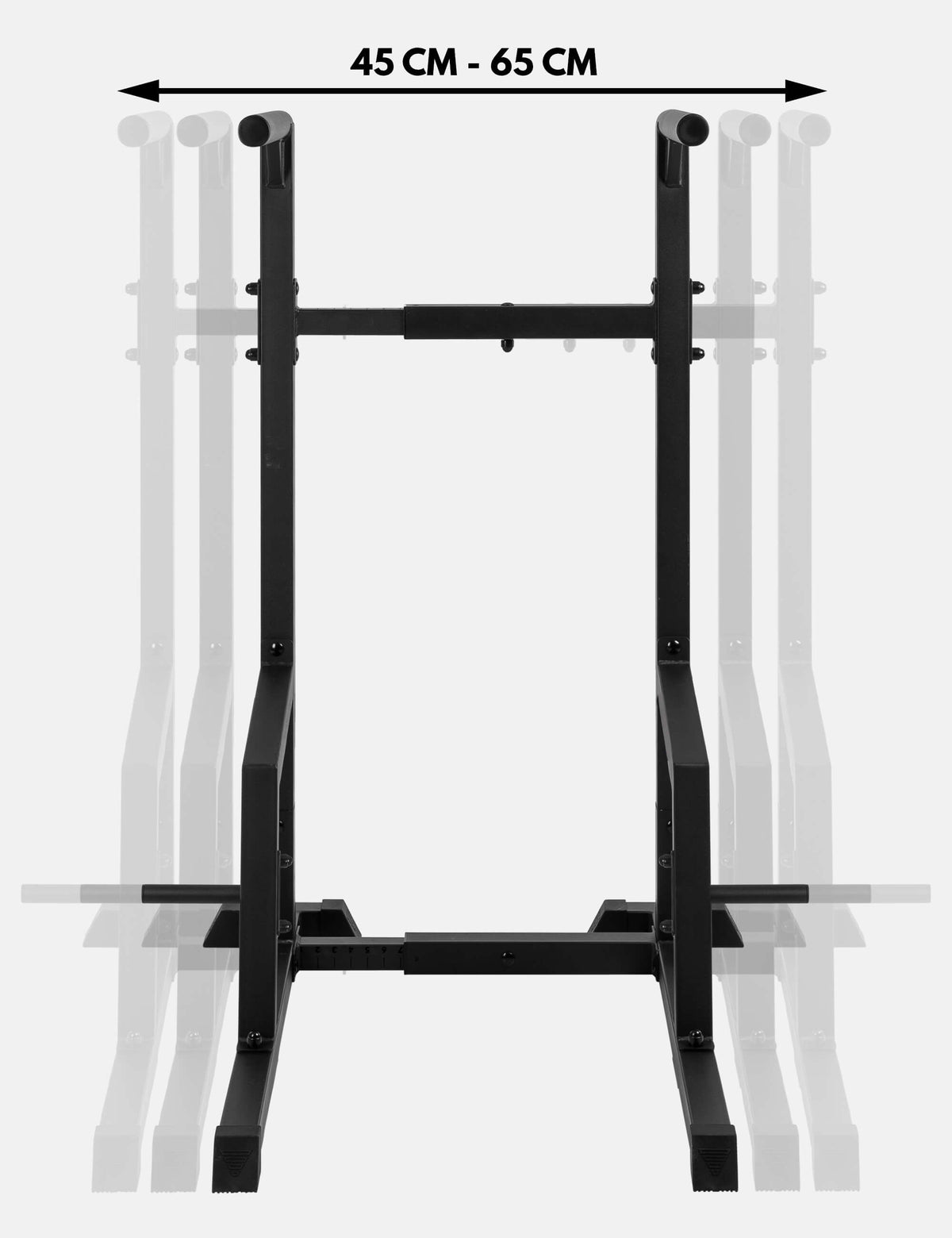Push-up bars are some of the most popular calisthenics equipment because they bring a great variety of exercises to your workout.
The best thing about push-up bars: You can use them anytime, anywhere, indoor or outdoor. You don't need a gym or calisthenics park.
In this blog, we will introduce you to 12 exercises that you can incorporate into your workout. We have chosen suitable exercises for every level, whether you are a beginner, advanced or professional.
Training on the floor (without push-up bars) can make for an uncomfortable wrist position, which also affects performance. When doing push-ups or the handstand, there is a high load on the wrists, which can cause pain. The push-up grips put the wrists in a comfortable and neutral position, which provides a better training result.
Another advantage is provided by the extended Range of Motion. Since the hands are a little further off the ground, you can go deeper when doing push-ups. Skills such as the l-sit, frog stand or tucked planche are also more enjoyable due to the increased range of motion.
For more benefits of push-up bars, check out our Parallettes Guide. Now let's move on to the 12 exercises with push-up bars:

1. Exercise: Push Ups
Probably the best known exercise is the push-up. The advantage of doing this on the parallettes is that you can go deeper and thus provide a greater muscle stimulus. The greater muscle stimulus in turn provides greater muscle and strength building.
Tip: You can adjust the position of your hands to perform wide or narrow push-ups, for example.

2. Exercise: Frog Stand
The frog stand is the basis for many other skills, such as tucked planche or handstand. You can ideally improve your body tension and develop a feeling for the advanced skills. For the frog stand, you grab the push-up grips and support yourself with your knees on your elbows. At first, the exercise can be very unfamiliar, as some balance is also required.
Tip: Over time, you can work on extending your arms completely. Use your elbows less and less to support your knees until you no longer need to rest your knees.

3. Exercise: Pike Push Ups
Pike push-ups can also be done without the push-up bars, but again you have the advantage of an extended range of motion. Keep your legs extended for a correct execution of the exercise.
Tip: The closer you place your feet to your hands, the more difficult and effective the exercise will be. The important thing here is to keep your legs extended.

4. Exercise: L-Sit
The l-sit is one of the basics in calisthenics and is therefore important for advanced skills, such as the front lever. The exercise not only looks aesthetically pleasing, but also uses muscles throughout the body, as high body tension is required.
Tip: Protract your shoulders and fully extend your arms to immediately ensure perfect form.

5. Exercise: Handstand
The handstand fascinates a lot of people and is considered very aesthetic and popular, not only in calisthenics. The combination of strength and balance takes a lot of time, training and patience to learn. For many athletes, the handstand on the parallettes is more comfortable because you have better control and can more easily push back if you lose balance.
Tip: Train the handstand with a partner or on the wall at first, because you will lose your balance very often. With a partner, you will benefit from a safer workout. It is also beneficial to learn the correct roll off from the handstand if you ever train alone.

6. Exercise: Tucked Planche
The tucked planche is the beginning of the advanced skills in calisthenics. It is very similar to the frog stand but with one big difference: the knees are not on the elbows, which makes the exercise much more difficult and puts more stress on the wrists. The push-ups counteract this and provide a more comfortable position for the wrists.
Tip: Push your shoulders out so that there is a slight hump. This will ensure perfect form. The arms must be fully extended.

7. Exercise: Hollow Back Handstand
The hollow back is a form of handstand that requires good mobility because you have a very strong hollow back. Strength-wise, the difference to the normal handstand is not very big, but the balance is different because the body's center of gravity is shifted. Start from the normal handstand and try to perform two movements at the same time:
Bent your legs further and further over your head and pushing your shoulders further and further in the opposite direction. If you only bent your legs over, you will quickly lose your balance.
Tip: Work a lot on your stretch and optimally learn a good bridge. This will make the hollow back much easier for you.

8. Exercise: Handstand Push Ups
Handstand push-ups require not only a very good balance, but also a lot of strength. It is one of the most popular exercises because the combination of balance and strength is also very fun. With handstand push-ups, you have a strong tendency to fall into a hollow back if you don't have enough strength for a clean execution.
Tip: Pike push-ups are one of the best exercises to build strength for the handstand push up.

9. Exercise: Straddle Planche
The goal of holding a straddle planche is very common in the calisthenics community. This skill takes some time and strength to learn. An important concept here is straight arm strength, which is made up of the following components: strong biceps and strong forearms. This strength is also needed for many other skills like the front lever, human flag or iron cross. The straddle planche also requires very strong shoulders and a strong core. A very good tucked planche is required to work on the straddle planche.
Tip: Work on your hip and leg mobility. You will find it easier to hold the straddle planche if you can open your hips better and spread your legs further apart.

10. Exercise: One Arm Handstand Flag
Not many can hold the one arm handstand flag because the difficulty of the exercise is very high. This makes the skill all the more attractive to many athletes, as it is not seen very often. A combination of human flag and handstand is just the beginning. Once you've mastered that, it's a matter of reaching perfection and holding the skill on just one hand.
Tip: Good mobility is also an advantage with this skill. The balance is also a bit unusual at the beginning, but you will soon develop a feeling for it. A generally good balance is a prerequisite here.

11. Exercise: Full Planche
The full planche is considered the "dream skill" in the calisthenics community. The progression from straddle planche to full planche is very large and requires a lot of dedication and training. The most important thing with the full planche is not to get discouraged by slow progress. For some athletes, the full planche can take years, while for others it can take only months.
Tip: Resistance Bands are very helpful in developing a better feel for the full planche and making your workouts more exciting. At the same time, you improve your technique and strength. It is also easy to track your progress as you can work with different strength resistance bands.

12. Exercise: One Arm Handstand
The one arm handstand is considered one of the most difficult skills in calisthenics. A highly developed balance is required. Without consistent training, it is almost impossible to learn the one arm handstand. The foundation is a clean and secure grip in the handstand. Try to grip the push-up bars a little tighter to be able to shift your weight more easily to one side. So-called weight shifts are a very popular exercise for the one arm handstand.
Tip: Film yourself as you work out to catch mistakes right away to improve your form each time. A wall can also be a very good help to develop the feeling of how to shift your weight properly.

Want to take your workout to the next level? Discover now the Premium Parallettes from GORNATION and train anywhere, anytime, without any restrictions.
 | 5.000+ Reviews
| 5.000+ Reviews
 Free EU Shipping above 100€*
Free EU Shipping above 100€*
 300.000+ Customers Worldwide
300.000+ Customers Worldwide












